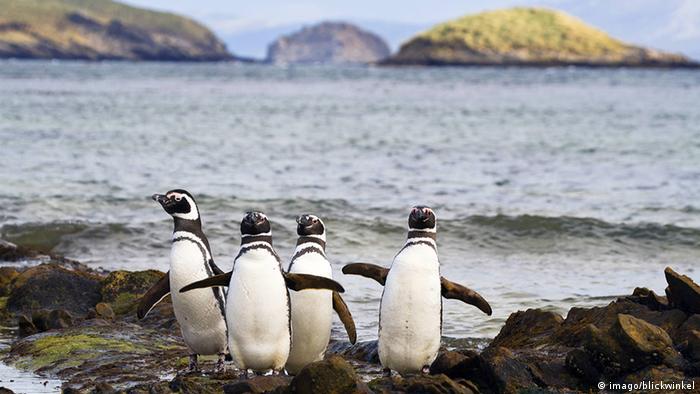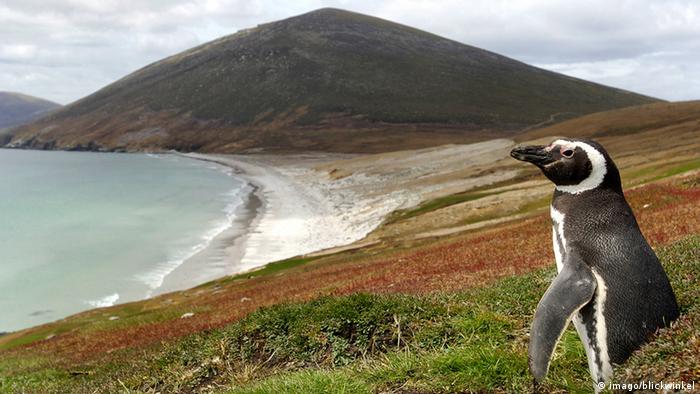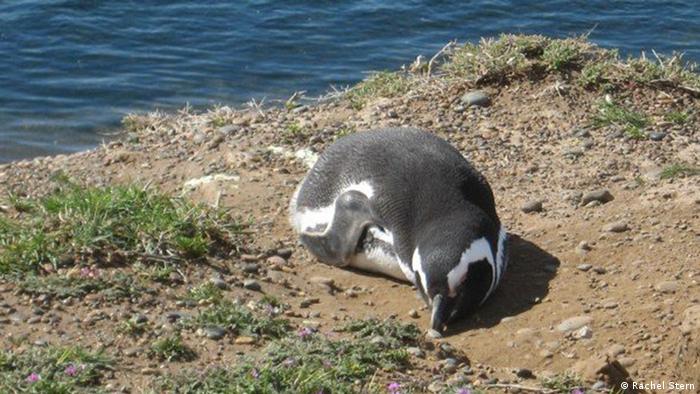Punta Tombo is a small, sandswept peninsula about 1,600 kilometres (994
miles) south of Buenos Aires, best known - as its bright blue signs
proclaim in English - as "Penguin Paradise."
Starting every September, hundreds of thousands of Magellanic Penguins migrate to these Patagonian shores to incubate their eggs and see their young off to sea. But it's not all paradisical for these majestic birds, which are known for their ability to swim distances of up to 170 kilometres (106 miles) a day. On the contrary, they continue to face threats from climate change, local industry and unsustainable tourism.
Punta Tombo attracts more than 100,000 tourists annually, most of whom come to primarily see the penguins. High visitor numbers are generally considered a good thing - but in this instance, that's not without difficulties. "There's a problem of managing large numbers of people wanting access to penguin colonies," said Graham Harris, director of the Wildlife Conservation Society's (WCS) Argentina program.
He points out that while crowds of people have helped keep predators such as foxes and seagulls away from the penguins, tourism has also taken its toll. It has led to the construction of additional facilities on the peninsula, to greater use of already scarce water resources and to sewage being leaked into the sea. And although safe group sizes should not be larger than 15 people, buses carry more numbers on unofficial tours to the coast.
The WCS first promoted the idea of small-group tourism in the 1960s as an economic alternative to hunting. At that time, the Japanese firm "Hinode Penguin" was seeking permission from Argentina's government to kill the birds for their skins. They were spared this fate, and in the 1970s, WCS and Germany's Frankfurt Zoo donated the funds to build the first ranger station at Punta Tombo to serve as a lookout for the penguins.
Biosphere reserve victory
Things have come a long way since then. Just last month, local conservation groups succeeded in their long-term push to form a UNESCO biosphere reserve. Known as the "Blue Patagonia" reserve, it covers an area of 3.1 million hectares - about the size of Belgium - that also encompasses Punta Tombo. About 58 percent of the area is at sea, and 42 percent on land.
While it includes a sustainable management plan for each reserve in the area - including limited tour group sizes and waste management - biosphere reserve status is not legally binding.
Regardless, Pablo Garcia Borboroglu, president of the Global Penguin Society (GPS), welcomes the designation as a means of tackling existing problems. "There will be a need to improve management techniques since there will be a need to report to UNESCO," he said.
 Nonetheless, it is only a first step in protecting Argentina's coastal
Patagonian penguins, the largest such colony in South America. Another
crucial aspect is public awareness of the problems facing the birds.
Nonetheless, it is only a first step in protecting Argentina's coastal
Patagonian penguins, the largest such colony in South America. Another
crucial aspect is public awareness of the problems facing the birds.
Early education
The scheme has given the youngsters an insight into the majestic black and white creatures. "The Argentines used to be the worst-behaved around them," said Borboroglu, referring to harassing the wildlife. "Now, they're the best."
Dee Boersma, who has been director of the Magellanic Penguin Project at Punta Tombo since 1982, agrees that sustainable tourism can be effective. "The good news is that visiting these penguins, when managed and done well, can educate people to help with their conservation," Boersma said.
But efforts don't stop there. Given that Magellanic Penguins nest as far as a kilometer inland from the shore, they often inhabit private property. The GPS and Wildlife Conservation Society are therefore working with landowners to protect these areas, and also put up cautionary signs for boats that sail past the birds' migratory corridors.
Protection at sea has already delivered results. In the early 1980s, nearly 80 percent of penguins found dead on the beach were covered in petroleum - yet when oil tankers were forced to move 40 kilometers further offshore, that figure dropped to 1 percent.
Other Threats
In a recent University of Washington study, Boersma noted that climate change is responsible for up to 7 percent of penguin deaths. Because they have no sweat glands, they pant like dogs and dilate their blood vessels to give off heat through their feet and the flippers.
"When it got hot, many penguins died because all their blood was being used to digest their food, and not for their feet and their flippers," said Boersma. In essence, they overheated.
Young penguins that are too big to be sheltered under their parents, but that don't yet possess waterproof feathers, are also susceptible to rainstorms.
Illegal fishing and over-foraging off the coast also poses a problem, as penguins and other local marine species need at least a third of available fish resources to sustain themselves. To save money, small ships also continue to dump oil into the sea instead of docking on shore.
"If we want [penguins' habitats] to have the protection they need, that's going to mean helping the government do the right thing," said Boersma. "Penguins don't have a voice, so people are going have to use their voice to help them."
source
Starting every September, hundreds of thousands of Magellanic Penguins migrate to these Patagonian shores to incubate their eggs and see their young off to sea. But it's not all paradisical for these majestic birds, which are known for their ability to swim distances of up to 170 kilometres (106 miles) a day. On the contrary, they continue to face threats from climate change, local industry and unsustainable tourism.
Punta Tombo attracts more than 100,000 tourists annually, most of whom come to primarily see the penguins. High visitor numbers are generally considered a good thing - but in this instance, that's not without difficulties. "There's a problem of managing large numbers of people wanting access to penguin colonies," said Graham Harris, director of the Wildlife Conservation Society's (WCS) Argentina program.
He points out that while crowds of people have helped keep predators such as foxes and seagulls away from the penguins, tourism has also taken its toll. It has led to the construction of additional facilities on the peninsula, to greater use of already scarce water resources and to sewage being leaked into the sea. And although safe group sizes should not be larger than 15 people, buses carry more numbers on unofficial tours to the coast.
The WCS first promoted the idea of small-group tourism in the 1960s as an economic alternative to hunting. At that time, the Japanese firm "Hinode Penguin" was seeking permission from Argentina's government to kill the birds for their skins. They were spared this fate, and in the 1970s, WCS and Germany's Frankfurt Zoo donated the funds to build the first ranger station at Punta Tombo to serve as a lookout for the penguins.
Biosphere reserve victory
Things have come a long way since then. Just last month, local conservation groups succeeded in their long-term push to form a UNESCO biosphere reserve. Known as the "Blue Patagonia" reserve, it covers an area of 3.1 million hectares - about the size of Belgium - that also encompasses Punta Tombo. About 58 percent of the area is at sea, and 42 percent on land.
While it includes a sustainable management plan for each reserve in the area - including limited tour group sizes and waste management - biosphere reserve status is not legally binding.
Regardless, Pablo Garcia Borboroglu, president of the Global Penguin Society (GPS), welcomes the designation as a means of tackling existing problems. "There will be a need to improve management techniques since there will be a need to report to UNESCO," he said.
 Nonetheless, it is only a first step in protecting Argentina's coastal
Patagonian penguins, the largest such colony in South America. Another
crucial aspect is public awareness of the problems facing the birds.
Nonetheless, it is only a first step in protecting Argentina's coastal
Patagonian penguins, the largest such colony in South America. Another
crucial aspect is public awareness of the problems facing the birds.Early education
Teaching youngsters about penguins is essential to conservation efforts
Borboroglu, who is a resident of Chubut province where Punta
Tombo is located, says local children learn about the penguins and their
environment at school. Every year, the local GPS chapter takes 700
children to see the birds and visit the newly renovated Penguin
Interpretation Center.The scheme has given the youngsters an insight into the majestic black and white creatures. "The Argentines used to be the worst-behaved around them," said Borboroglu, referring to harassing the wildlife. "Now, they're the best."
Dee Boersma, who has been director of the Magellanic Penguin Project at Punta Tombo since 1982, agrees that sustainable tourism can be effective. "The good news is that visiting these penguins, when managed and done well, can educate people to help with their conservation," Boersma said.
But efforts don't stop there. Given that Magellanic Penguins nest as far as a kilometer inland from the shore, they often inhabit private property. The GPS and Wildlife Conservation Society are therefore working with landowners to protect these areas, and also put up cautionary signs for boats that sail past the birds' migratory corridors.
Protection at sea has already delivered results. In the early 1980s, nearly 80 percent of penguins found dead on the beach were covered in petroleum - yet when oil tankers were forced to move 40 kilometers further offshore, that figure dropped to 1 percent.
Other Threats
In a recent University of Washington study, Boersma noted that climate change is responsible for up to 7 percent of penguin deaths. Because they have no sweat glands, they pant like dogs and dilate their blood vessels to give off heat through their feet and the flippers.
"When it got hot, many penguins died because all their blood was being used to digest their food, and not for their feet and their flippers," said Boersma. In essence, they overheated.
Young penguins that are too big to be sheltered under their parents, but that don't yet possess waterproof feathers, are also susceptible to rainstorms.
Illegal fishing and over-foraging off the coast also poses a problem, as penguins and other local marine species need at least a third of available fish resources to sustain themselves. To save money, small ships also continue to dump oil into the sea instead of docking on shore.
"If we want [penguins' habitats] to have the protection they need, that's going to mean helping the government do the right thing," said Boersma. "Penguins don't have a voice, so people are going have to use their voice to help them."
source




















No comments:
Post a Comment